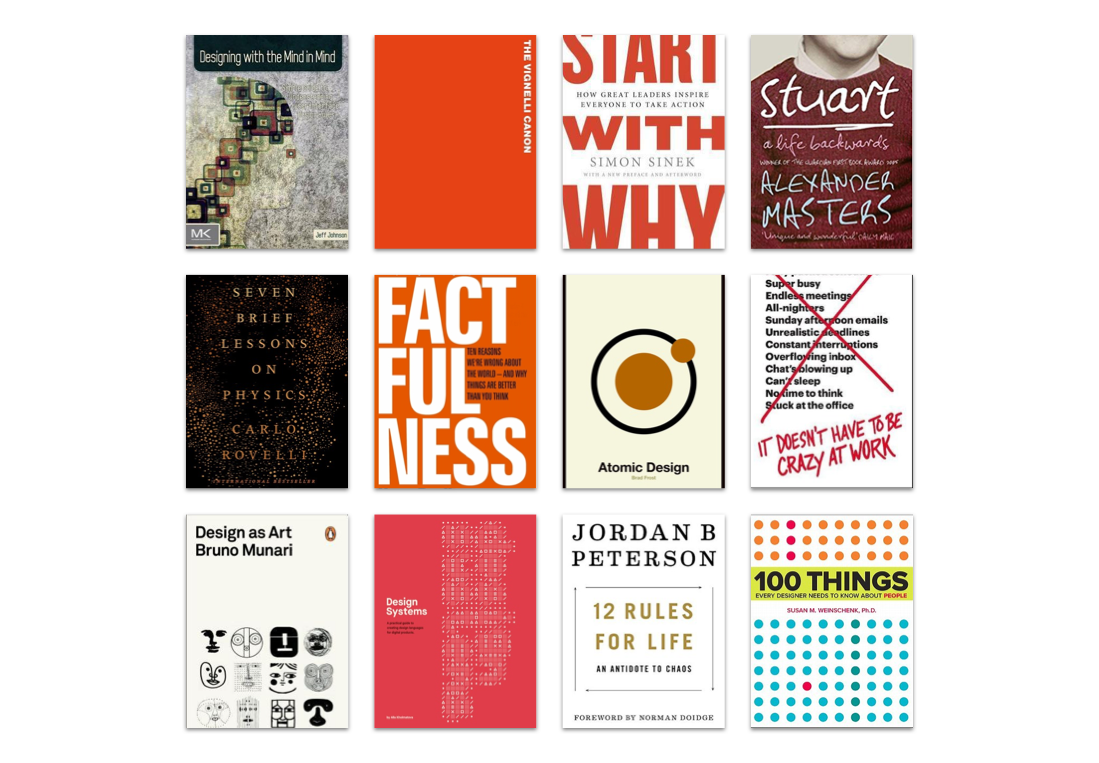
Of the 45 books I read in 2018, these are the ones that made more of an impact both on my designer self, and on my self-self.
Atomic Design
Brad Frost
Frost introduces here the concept of Atomic Design, a practical methdology for creating and maintaining design systems. He proposes that UI components can - and should - be organised hierarchically, from the smallest of unities – atoms – to templates and pages.
It’s a very good introduction to design systems, and can be read for free on his website.
100 Things Every Designer Needs to Know about People
Susan M. Weinschenk
This is a very good - and very visual - compilation of cognitive biases and other human quirks. Highly readable, and a great introduction to the intricacies of human behaviour and how design can influence it.
Design Systems: A practical guide to creating design languages for digital products
Alla Kholmatova
The red book! Design Systems comes in a small format with bright red hard covers and shiny white pages explaining how you can set up and maintain a design system. It’s a great one to have on hand, especially for teams that are just getting started with their design system.
The Vignelli Canon
Massimo Vignelli
Absolutely wonderful book about design. It’s a classic one that hasn’t dated one bit where designer Massimo Vignelli explains what he understands for good design and describes what his rules and criteria are when it comes to designing.
Design Rules
Jeff Johnson
Another great one on human behaviour and how to design accordingly. Some examples might seem a bit dated, but us human beings take much longer than technology to change, so most of the behaviour it describes is still valid.
Design as Art
Bruno Munari
I had to see this little gem a thousand times before I finally decided to go for it and read it. It’s small yet packed with insight, curiosity and anecdotes. It’s beautifully written and I really, really enjoyed reading it. It’s a great book about, well, design as art, and how the two disciplines converge more often than not.
Start with why
Simon Sinek
In this book, Sinek argues that if you have purpose, you’ll find the way. That if a company understands why they exist, they can go on to do anything as long as they never lose sight of that. That the what and the how are the ones everyone knows – but the why is what really matters.
Seven Brief Lessons on Physics
Carlo Rovelli
Seven Brief Lessons on Physics is not a design book per se, yet it is living proof that a well-designed book on physics – short, concise and beautifully written – can appeal to anyone. Even to me.
Stuart: A Life Backwards
Alexander Masters
This is an odd one: an account of the friendship between journalist and screenwriter Alexander Masters and Stuart Shorter, a homeless addict Masters had met by mere chance back in the nineties.
The book is a raw biography of a nobody who is actually a somebody, but what struck me the most is how original the narration is: it’s told backwards. From the moment Stuart dies (sorry, spoiler alert) to when we get to know how - and why - he became the adult he was, the narrative of Stuart’s life is honest, intricate and fascinating. Yet another great example of how we tend to go from the what to the why, rather than the other way around.
12 Rules for Life: An Antidote to Chaos
Jordan B. Peterson
I was already familiar with Peterson, and his 12 Rules for Life made a great impact on me. More than a self-help book, this is a collection of ramblings on how to be – not necessarily happy – but, well, just content. It’s about how life really quite sucks, but all you can do about it is to make it a little bit better for yourself and others close to you, one a day at a time.
It’s bleak, and dense, and long, but it’s well worth it.
It Doesn’t Have to Be Crazy at Work
David Heinemeier Hansson and Jason Fried
From the founder and CEO of Basecamp comes this book about how not to be crazy at work – or how not make work a crazy place to be. It’s just a list of rules and ideas that are quite common sense, really, and yet most companies are not really applying.
Like working only 40 hours a week, having time for yourself, your hobbies, your family, not wasting anyone’s time in meetings, not micro-managing your direct reports, and all that jazz.
It’s sad to say it, yet it’s true: most of us need this book.
Factfulness: Ten Reasons We’re Wrong About the World – and Why Things Are Better Than You Think
Hans Rosling
To end this list on a positive note, Factulness is a breath of fresh air in that it uses data to make us – readers – feel better about the world and where we’re going globally.
It argues that we all fall into ten biases or instincts that distort our perspective — from our tendency to divide the world into two camps (usually some version of us and them) to the way we consume media (where fear rules) to how we perceive progress (believing that most things are getting worse).
I really recommend it, especially if you like to challenge other people’s beliefs. I read this over the Christmas break while I was back home with family and in-laws. It was a fun one to discuss over pudding.